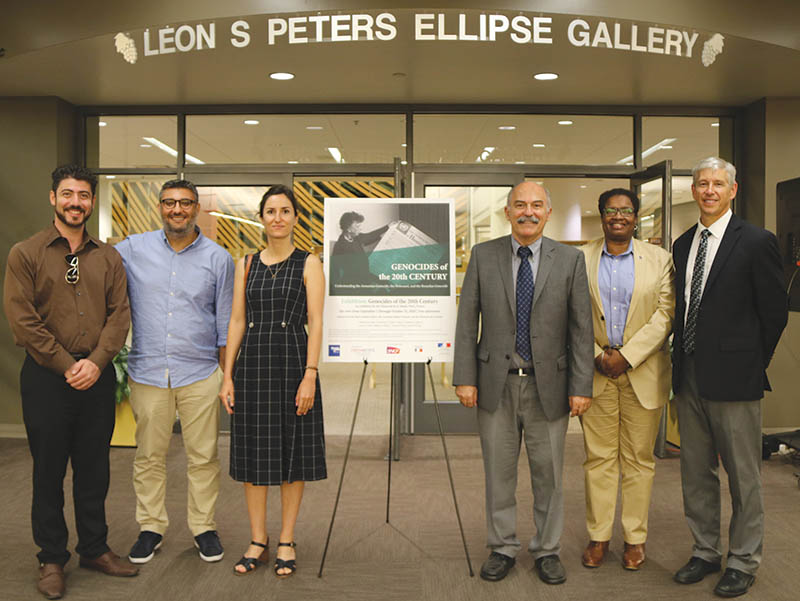
Sinclair, Prof. Barlow Der Mugrdechian, Dean Del Hornbuckle,
and Dr. Clint Curle. Photo by: Andrew Hagopian
Annie Rubio
Editor
“Sovereignty cannot be conceived as the right to kill millions of people.” These words were spoken by Rafael Lemkin, an American lawyer of Polish-Jewish heritage who coined the term “genocide.” It is difficult to fathom the number of atrocities committed throughout history, but even more difficult to fathom what Winston Churchill once called, “a crime without a name.” Lemkin set out to define and name the crime perpetrated against the Jews during World War II, in hopes that justice would follow. By doing so, he also put into general use the term now used to characterize the Armenian Genocide of 1915.
The Armenian Studies Program and the Henry Madden Library, in partnership with the Mémorial de la Shoah of Paris, are co-sponsoring an exhibition “Genocides of the 20th Century,” which will be on view at the 2nd Floor Leon S. Peters Ellipse Gallery of the Library until October 31. The exhibition focuses on the Armenian Genocide, the Jewish Holocaust, and the Rwandan Genocide, while touching on other contemporary genocides as well. This touring exhibition reaches many diverse audiences in its mission to educate and prevent genocide.
The Opening Reception for the exhibition was held in the Madden Library on Thursday, September 6. Prof. Barlow Der Mugrdechian, Director of the Armenian Studies Program, who planned the exhibition’s coming to Fresno State, gave introductory remarks. Special guests included Delritta Hornbuckle, Dean of Library Services at Fresno State’s Henry Madden Library and Dean Dr. Saúl Jiménez-Sandoval, Dean of the College of Arts and Humanities at Fresno State, as well as many faculty, students, and members of the community.
Deborah Sinclair, Head of Touring Exhibitions for the Mémorial de la Shoah, introduced the exhibition as a basis of reflection for how to prevent genocides. “Comparing genocides does not take away their specificities… It leads to a better understanding of their mechanisms.”
Although the exhibit features three main genocides of the twentieth century, it does not mean there is no room to honor and recognize others. “All victims of genocide are entitled to the same interest, the same sympathy, and that should lead us to looking into other genocides,” stated Sinclair. The exhibition examines what happened during each genocide, connecting the present to the past. Sinclair hopes that it will serve as a driving force for recognition that is necessary today.
Dr. Clint Curle, Senior Advisor to the President at the Canadian Museum of Human Rights, in Winnepeg, was the featured speaker for the evening. He spoke on the concept and patterns of genocides and opened with his frank sentiment, “I wish we didn’t have to have this talk.” Before the formal definition of genocide, international laws were based of sovereignty of nations and did not criminalize the actions of governments.
The Nuremberg Trials served as a time to reestablish the law in Europe. Dr. Curle also discussed the work of Rafael Lemkin in defining genocide. Lemkin identified physical, biological, and cultural techniques in genocides that result in the complete erasure of a race.
The discussion shifted the topic from the history of genocides to the prevention of them. The broad passive complicity of the public enables the execution of a genocide. “The vulnerability of every genocide is that it requires people to sit on their hands,” said Dr. Curle.

Dr. Curle introduced a method of genocide prevention to combat this. The public health model is based in education, comparing the eradication of genocide to the development of the polio vaccine. Beginning with children, education on genocides and dehumanization can prevent the “disease” of genocide.
By continually educating them, they can be empowered to prevent genocides in the future.
Dr. Clure left the audience with the sentiment, “genocide will end when we stand up against racism and oppression.”
The Fresno State College of Arts and Humanities, College of Social Sciences, the Jewish Studies Program, the Consulate General of France in San Francisco, the Embassy of France in the United States, and SNCF also supported the showing.
This exhibition was designed, created, and distributed by the Mémorial de la Shoah in Paris, France (curators Georges Bensoussan, Joel Kotek, and Yves Ternon), and made possible through the generous support of SNCF.
 Hye Sharzhoom Armenian Action
Hye Sharzhoom Armenian Action